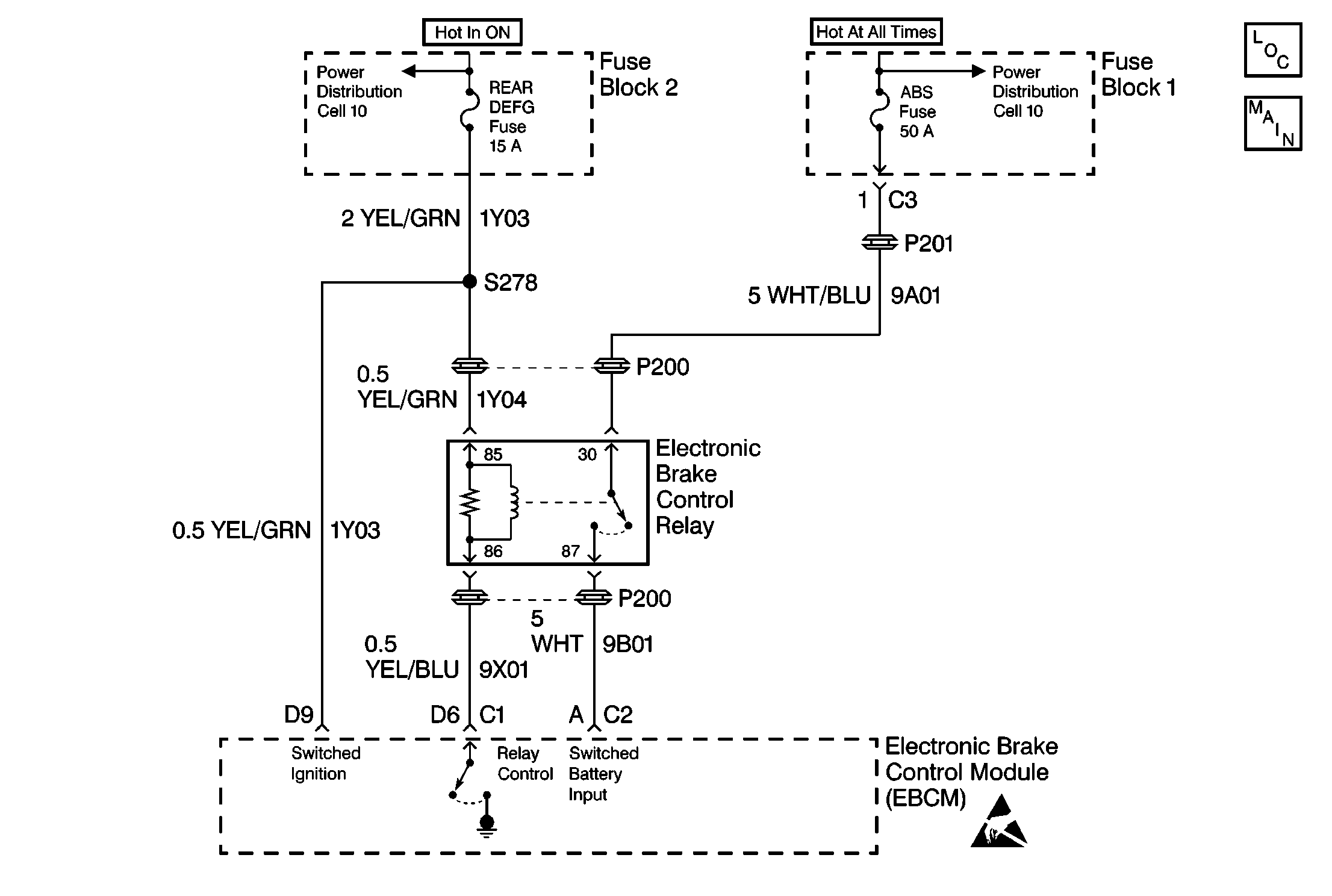
Circuit Description
This DTC is used to monitor the voltage level available to the EBCM. If the voltage drops below specific levels at specific times, full performance of the ABS system cannot be guaranteed. During an ABS event, there are several current requirements that will cause battery voltage to drop. Because of this, voltage is monitored prior to an ABS event and also during an ABS event operation when voltage may drop significantly.
Conditions for Setting the DTC
| • | DTC C1236 can set only if the vehicle's speed is greater than 5 km/h (3 mph). |
| • | A malfunction exists if the switched battery voltage is less than 11.4 volts without ABS being active or less than 8.4 volts during an ABS event. |
Action Taken When the DTC Sets
| • | A malfunction DTC stores. |
| • | The ABS disables. |
| • | The ABS warning indicator turns ON. |
Conditions for Clearing the DTC
| • | The condition responsible for setting the DTC no longer exists and the Scan Tool Clear DTCs function is used. |
| • | 100 drive cycles pass with no DTCs detected. A drive cycle consists of starting the vehicle, driving the vehicle over 16 km/h (10 mph), stopping and then turning the ignition off. |
Diagnostic Aids
If DTC C1214 is also set, refer to DTC C1214 Brake Control Relay Contact Circuit Open table.
The following conditions may cause an intermittent malfunction:
| • | A poor connection |
| • | Rubbed-through wire insulation |
| • | A broken wire inside the insulation |
| • | Vehicle charging system is not operating properly (low alternator output, faulty battery) |
| • | High resistance in CKTs 1Y03, 9V01 and 9B01 |
| • | Poor G102 |
Use the enhanced diagnostic function of the Scan Tool in order to measure the frequency of the malfunction.
Thoroughly inspect any circuitry that may be causing the intermittent complaint for the following conditions:
| • | Backed out terminals |
| • | Improper mating |
| • | Broken locks |
| • | Improperly formed or damaged terminals |
| • | Poor terminal-to-wiring connections |
| • | Physical damage to the wiring harness |
Ensure the starting and charging systems are in proper working order. The battery should be fully charged and in good condition before beginning the diagnostic table. Refer to Battery and Charging System.
Important: Zero the J 39200 test leads before making any resistance measurements. Refer to the J 39200 user's manual.
Step | Action | Value(s) | Yes | No | ||||||||||||||||
|---|---|---|---|---|---|---|---|---|---|---|---|---|---|---|---|---|---|---|---|---|
1 | Was the Diagnostic System Check performed? | -- | Go to Diagnostic System Check | |||||||||||||||||
2 |
Do not start the engine. Does DTC C1236 set as a current DTC? | -- | ||||||||||||||||||
3 |
Is the Ignition Voltage equal to or greater than the specified voltage? | 10 V | ||||||||||||||||||
4 |
Is the resistance within the specified range? | 0-2 ohms | ||||||||||||||||||
5 |
Is the resistance within the specified range? | 0-2 ohms | ||||||||||||||||||
6 |
Is the resistance within the specified range? | 0-2 ohms | ||||||||||||||||||
7 | Use the J 39200 in order to measure the resistance between the fuse block terminal (REAR DEFG Fuse [15A]) and the EBCM connector terminal D9. Is the resistance within the specified range? | 0-2 ohms | ||||||||||||||||||
8 |
Are there signs of terminal damage, poor terminal contact, or terminal corrosion? | -- | ||||||||||||||||||
9 |
Does DTC C1236 set as a current DTC? | -- | ||||||||||||||||||
10 | Repair the low voltage condition. Refer to Wiring Systems. Is the low voltage condition repaired? | -- | Go to Diagnostic System Check | -- | ||||||||||||||||
11 | Repair the open or high resistance in CKT 9B01. Is the repair complete? | -- | Go to Diagnostic System Check | -- | ||||||||||||||||
12 | Repair the open or high resistance in CKT 9A01. Is the repair complete? | -- | Go to Diagnostic System Check | -- | ||||||||||||||||
13 | Repair the open or high resistance in CKT 1Y04 and 1Y03. Is the repair complete? | -- | Go to Diagnostic System Check | -- | ||||||||||||||||
14 | Repair the open or high resistance in the power feed circuits to the fuse block. Refer to Power Distribution Schematics in Wiring Systems. Is the repair complete? | -- | Go to Diagnostic System Check | -- | ||||||||||||||||
15 | Replace all of the terminals or the connectors that exhibit signs of poor terminal contact, corrosion, or damaged terminals. Is the repair complete? | -- | Go to Diagnostic System Check | -- | ||||||||||||||||
16 | Replace the EBCM. Refer to Electronic Brake Control Module Replacement . Is the repair complete? | -- | Go to Diagnostic System Check | -- | ||||||||||||||||
17 | The malfunction is intermittent or is not present at this time. Refer to Diagnostic Aids for more information. Is the action complete? | -- | System OK | -- |
